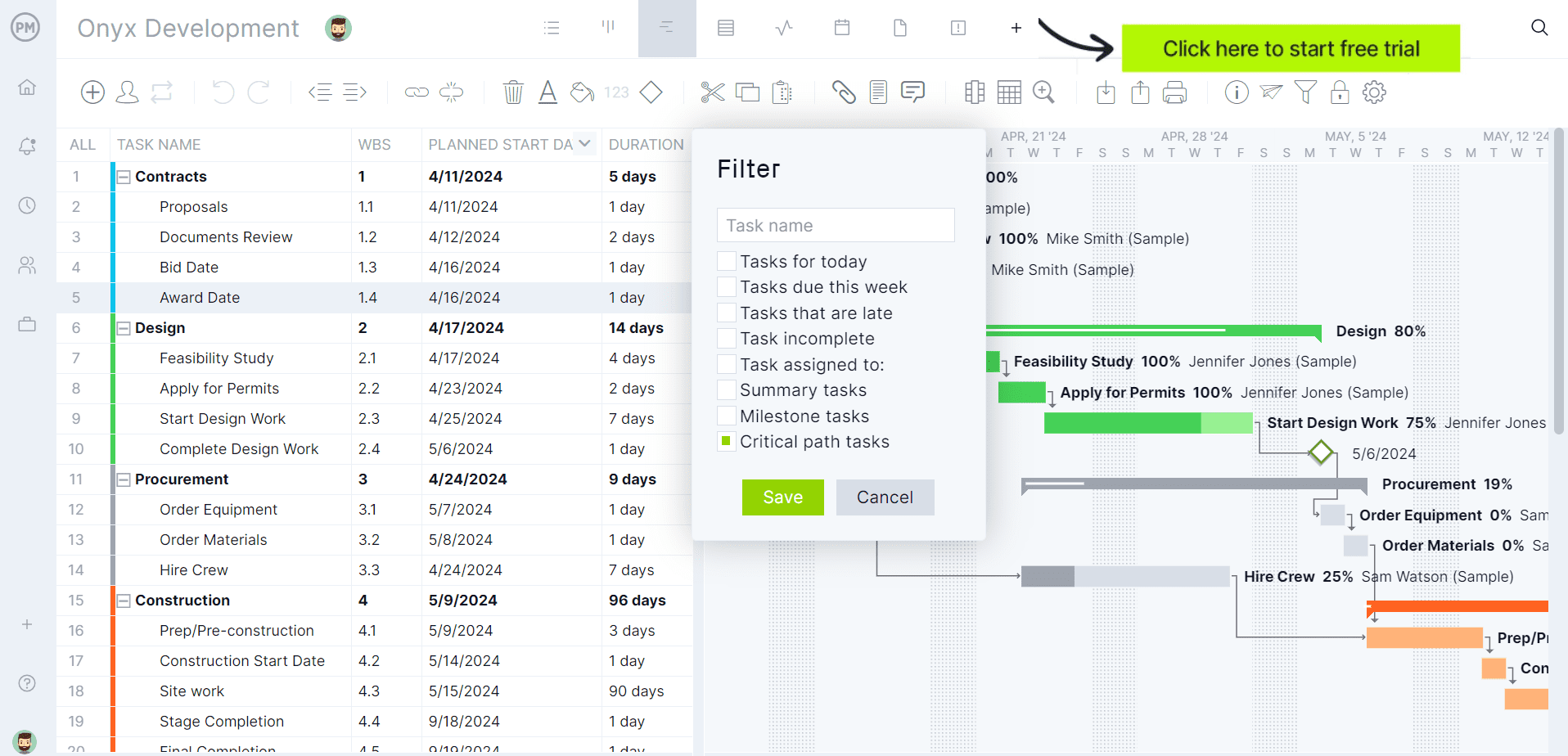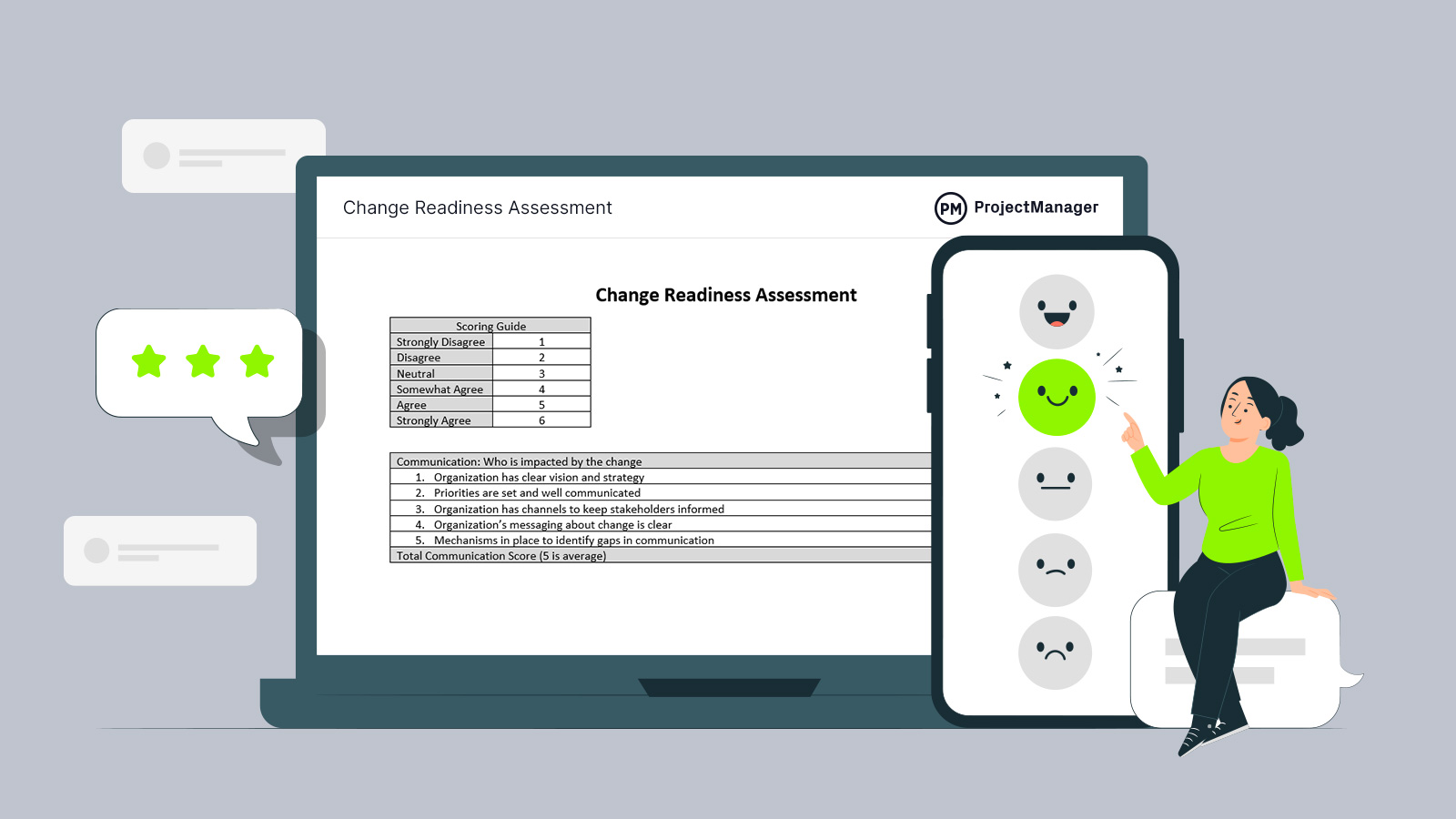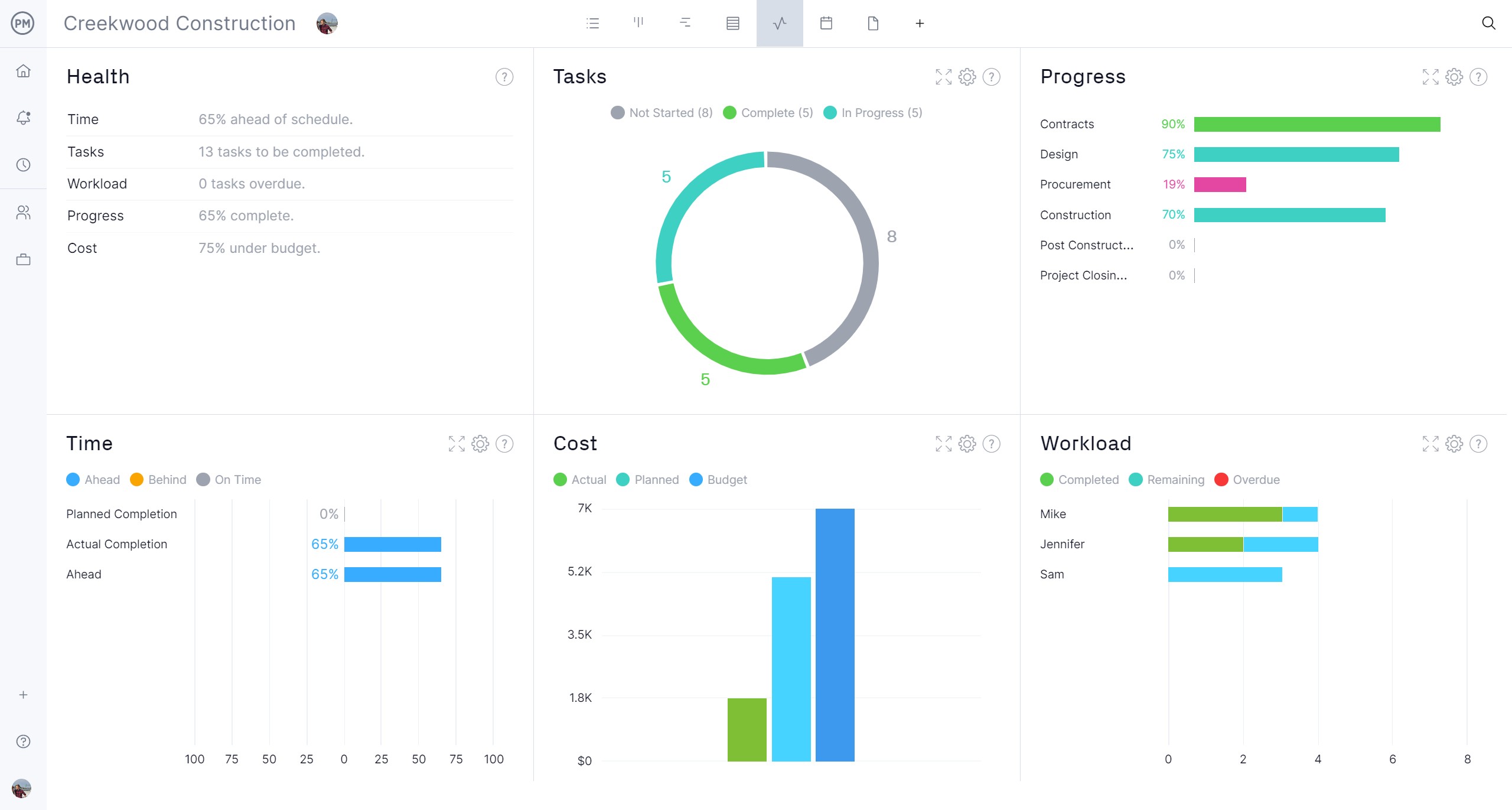The adage says nothing is constant but change. It might be a cliche, but those who ignore it are doomed to learn a lesson the hard way. When managing projects, change management helps to avoid its negative effects, and a change readiness assessment is one of the ways how it does this.
Being prepared for change helps to mitigate the risks associated with those changes. The first step is understanding what is a change readiness assessment and how and when to conduct one. We’ll go over that and the benefits of a change readiness assessment, including a free template to use when managing projects.
What Is a Change Readiness Assessment?
A change readiness assessment is a way to understand whether an organization or project is prepared for a specific change. It’s a means to know if the organization’s or project’s ability to initiate, follow through and maintain lasting changes.
This is done through a process of analysis that touches the organization or project at all levels. It must be a holistic assessment to be effective. That means considering everything from individuals in the organization to working groups, teams, departments, divisions, sectors, organizations, enterprises, networks, local and regional government and economy, national government economy and other stakeholders.
The professionals leading a change readiness assessment will then use those results as a way to inform a project plan that will initiate the change in the organization. They consider factors such as conditions, resources and capacity, motivation, attitude and culture. Once they’re ready to implement that change, they’ll use project management software to plan, manage and track progress, costs and more.
ProjectManager is award-winning project and portfolio management software with multiple views to plan change and execute it collaboratively across the organization. Managers can plan the project to implement the change on powerful Gantt charts, which link dependencies to avoid costly delays, filter for the critical path to identify essential tasks and set a baseline to track progress, costs and more in real time. The plan can be shared on task lists and kanban boards for the team to manage their work and stakeholders can use the calendar view to get an overview of the project. Get started with ProjectManager today for free.

When to Conduct a Change Readiness Assessment
Doing a change readiness assessment can occur at any time. If there’s a change coming, an organization wants to be prepared. This is done by first making a change readiness assessment. It’s most commonly used before the implementation of an organizational change.
The change readiness assessment is a great tool to identify areas of improvement and find the strengths and weaknesses in the organization and then plan to change them to make improvements to the overall organization.
Conduct a change readiness assessment to identify potential challenges and address them before they become issues that impact the organization. Another reason to conduct a change readiness assessment is to prepare the organization’s workforce to better understand the organization’s needs.
Change Readiness Assessment vs. Change Impact Assessment
A change impact assessment is a process organizations use to understand the potential impact of proposed changes on their business. It’s part of the larger change management process and compares the current and future states of change to identify what’s changing, who’s impacted and what those impacted need to know.
On the other hand, a change readiness assessment provides a more holistic view of a change initiative beyond its potential impact and helps organizations determine its feasibility from a resource management and strategic planning standpoint.

Get your free
Change Readiness Assessment Template
Use this free Change Readiness Assessment Template for Word to manage your projects better.
How to Conduct a Change Readiness Assessment
Now that the definition of a change readiness assessment has been made clear and when an organization will want to conduct one has been explained, let’s look at the steps for a thorough change readiness assessment.
1. Define the Purpose and Scope of Your Change
To properly assess the change and an organization’s readiness to respond, that change first has to be defined. Understand all the elements and stakeholders, the purpose of the change and what the scope of change will be over a timeframe. Be specific to more accurately assess the ability of the organization to adopt the change.
2. Ensure Strategic Alignment
Change should only be adopted if it aligns with the overall strategic plans of that organization. That is, the change should be harmonious with all departments, teams, processes and systems to work together towards a common goal. If the change is too disruptive to the organization’s strategic plans, it should be avoided.
3. Estimate the Potential Benefits and Risks of Your Change
Another thing to consider is the benefits of implementing that change and also identifying any risks it might pose to the organization. Listing the benefits allows managers to monitor that they get those benefits. If there aren’t enough benefits or too many risks involved then maybe the change isn’t worth it. If the risks are worth taking, they must be identified and tracked until mitigated.
4. Conduct a Gap Analysis
One way to be prepared for change is by conducting a gap analysis, which is a process that compares the current state with the desired future state. This is done to identify gaps and determine how to get from the current state to the future one.
5. Identify Resource Requirements of the Change
When the change readiness assessment is done and a plan is being put in place to implement those changes, managers will have to think of the resources they’ll need to execute the plan. Resources are anything needed to execute project tasks, from people to equipment, tools, money, facilities and raw materials.
6. Make a Change Readiness Matrix
A change readiness matrix is a visual tool that compares and contrasts the readiness of an organization from the perspective of different stakeholder groups. It can identify strengths and weaknesses, gaps in each group and prioritize actions to be taken. Once done, it’s also a great tool for communicating findings to stakeholders.
7. Map Stakeholders and Gauge Their Resistance to Change
Change is going to impact more than the operation and its teams, but the stakeholders who are invested in the organization. Therefore, it’s critical to map those stakeholders to identify them and their relationship with the organization. One of the major aspects of mapping stakeholders is to see how open or not they are to that change. This information is critical to the successful implementation of those changes.
Key Benefits of Assessing Change Readiness Before Implementing an Organizational Change
There are many reasons why an organization must conduct a change readiness assessment before implementing organizational change. Here are just a few reasons.
Prepares Your Organization for Any Potential Risks or Issues
There are always changes on the horizon or challenges that an organization has to face. A change readiness assessment prepares the organization for those changes and identifies obstacles and risks, so the organization can set up plans to mitigate or take advantage of those changes.
Ensures Stakeholder Satisfaction & Organizational Alignment
Since the due diligence is done with stakeholders before implementing or responding to change, managers know how they’ll react and can tailor their actions to ensure the stakeholders’ satisfaction. Without that process, stakeholders can be blindsided and never on board with the change. At the same time, a change readiness assessment makes sure that the change will align with the larger strategic initiatives of the organization.
Helps Accurately Estimate the Expected Timeline and Costs Related to the Change
Creating a plan to implement or respond to the change means understanding the resources, costs and timeline involved. This allows that change to be managed and not grow out of control, which can be financially dangerous as well as a long-term strain on the organization.
Change Readiness Assessment Questionnaire
One component of a change readiness assessment is asking questions. Using a change readiness assessment questionnaire helps organizations evaluate their preparedness and ability to navigate change. It also helps to see how well the organization is controlling change when it’s already in the works, which allows for adjustments to make the most of those changes. Here’s a list of some commonly asked change readiness assessment questions.
- What is the purpose of the change?
- What are the expected benefits of the change?
- What are the potential risks related to the change?
- What is the risk tolerance of your organization?
- What is the current state before the change?
- What is the desired state after the change?
- How will this change be implemented?
- What change management documentation will be utilized?
- Who will participate in the change implementation process?
- Who is the executive sponsor for this change?
- Who are the members of the change management team?
- What resources will be needed to implement the change?
- Are there enough resources to sustain the change over time?
- Who are the stakeholders for this change?
- How will stakeholders be informed about the change?
Change Readiness Assessment Template
To facilitate the change readiness assessment process, download this free change readiness assessment template for Word. It’s a simple document that captures questions for various topics with space for a numerical response.
The free change readiness assessment template for Word is broken up into categories, including sponsorship, stakeholder management, readiness and training. The numerical rating is one through six, with one being “strongly disagree” and six being “strongly agree.”
Free Change Management Templates
The free change readiness assessment template is only one of over 100 free project management templates for Excel and Word that can be downloaded to help manage every aspect of a project across multiple industries. These are some of the free templates that are related to change management.
Change Log Template
A change log is a document that captures change as it happens and allows managers to track the change until it’s put to bed. This free change log template for Excel lists the change, who it’s assigned to, the priority, the expected resolution and much more.
Change Request Template
Use this free change request template for Word to prepare, equip and support change. This free template allows managers to ensure that the change being implemented is thorough and smoothly done.
Change Order Template
This template is often used in construction projects but can be used in any industry to capture any modifications to the scope of work in a project. The change order template for Excel explains the opportunity of the change, its reason, duration and more.
ProjectManager Identifies and Controls Change
Change management can be done with templates, but it’s not ideal. Templates are static documents that must be manually updated. That takes time away from more important tasks, such as implementing the change. Responding to change is also a collaborative process and templates that are standalone documents are notoriously difficult to use for collaboration. To better manage change requires a more efficient model of project management software.
ProjectManager is award-winning project and portfolio management software that can respond to change by planning on Gantt charts and sharing those plans on kanban boards and list views that update automatically to keep everyone on the same page. But that’s only the start of the benefits of using ProjectManager.
Track Change, Risk and Issues
Risk comes with change and being able to identify and track those risks until they’re resolved is a critical part of change management. Use our risk, issue and change task cards to manage those things in real time. The cards collect vital information, such as due date, priority, assignee, response, description, tags, resolution, impact and likelihood as well as attaching comments and files as teams collaborate on identifying risk or managing issues and change.

Monitor and Report on Progress, Cost and More
As change is implemented or resolved, those actions must be monitored to ensure that they’re not delaying the project or causing excess costs that the budget can’t contain. Managers can get a high-level overview of the project with real-time project or portfolio dashboards, which automatically collect live data and display them on easy-to-read charts and graphs that show time, cost, workload and more. For more details, use customizable reports on project or portfolio status, variance, timesheets and more. Then share reports with stakeholders to keep them updated.

Related Change Management Content
Change management is a large subject and change readiness assessment is but a small part of it. For those interested in learning more, our site is a hub for all things project management. We publish blogs weekly, ebooks, guides, tutorial videos and, of course, free templates. Here are some that touch on change management.
- 10 Free Change Management Templates for Excel and Word
- How to Make a Change Management Plan (Templates Included)
- What Is Change Management? Process & Models Explained
- What Is Change Control in Project Management?
- Change Control Board: Roles, Responsibilities & Processes
ProjectManager is online project and portfolio management software that connects teams whether they’re in the office, out in the field or anywhere else. They can share files, comment at the task level and stay updated with email notifications and in-app alerts. Join teams from Avis, Nestle and Siemens who use our software to deliver successful projects. Get started with ProjectManager today for free.
The post How to Conduct a Change Readiness Assessment (Template Included) appeared first on ProjectManager.







